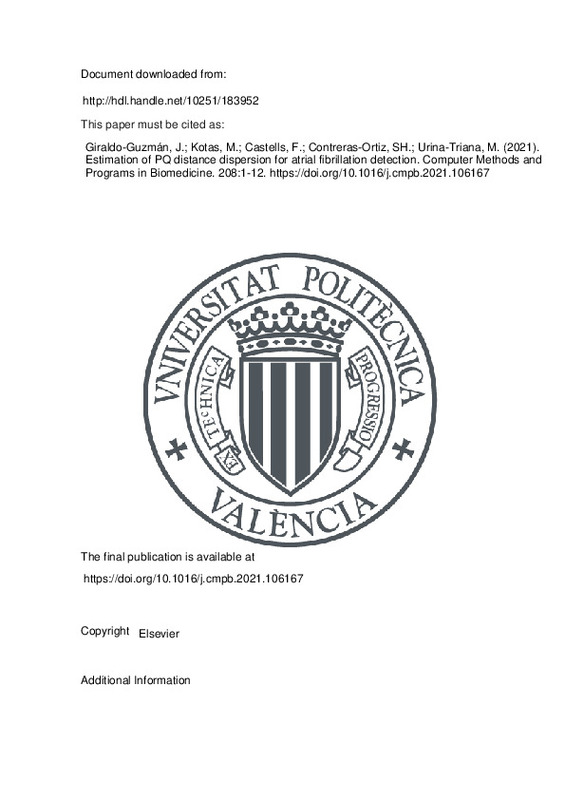Giraldo-Guzmán, J.; Kotas, M.; Castells, F.; Contreras-Ortiz, SH.; Urina-Triana, M. (2021). Estimation of PQ distance dispersion for atrial fibrillation detection. Computer Methods and Programs in Biomedicine. 208:1-12. https://doi.org/10.1016/j.cmpb.2021.106167
Por favor, use este identificador para citar o enlazar este ítem: http://hdl.handle.net/10251/183952
|
Título:
|
Estimation of PQ distance dispersion for atrial fibrillation detection
|
|
Autor:
|
Giraldo-Guzmán, Jader
Kotas, Marian

 Castells, Francisco
Contreras-Ortiz, Sonia H.
Urina-Triana, Miguel
Castells, Francisco
Contreras-Ortiz, Sonia H.
Urina-Triana, Miguel
|
|
Entidad UPV:
|
Universitat Politècnica de València. Departamento de Ingeniería Electrónica - Departament d'Enginyeria Electrònica
|
|
Fecha difusión:
|
|
|
Resumen:
|
[EN] Background and objective: Atrial fibrillation (AF) is the most common cardiac arrhythmia in the world. It is associated with significantly increased morbidity and mortality. Diagnosis of the disease can be based on ...[+]
[EN] Background and objective: Atrial fibrillation (AF) is the most common cardiac arrhythmia in the world. It is associated with significantly increased morbidity and mortality. Diagnosis of the disease can be based on the analysis of the electrical atrial activity, on quantification of the heart rate irregularity or on a mixture of the both approaches. Since the amplitude of the atrial waves is small, their analysis can lead to false results. On the other hand, the heart rate based analysis usually leads to many unnecessary warnings. Therefore, our goal is to develop a new method for effective AF detection based on the analysis of the electrical atrial waves.
Methods: The proposed method employs the fact that there is a lack of repeatable P waves preceding QRS complexes during AF. We apply the operation of spatio-temporal filtering (STF) to magnify and detect the prominent spatio-temporal patterns (STP) within the P waves in multi-channel ECG recordings. Later we measure their distances (PQ) to the succeeding QRS complexes, and we estimate dispersion of the obtained PQ series. For signals with normal sinus rhythm, this dispersion is usually very low, and contrary, for AF it is much raised. This allows for effective discrimination of this cardiologic disorder.
Results: Tested on an ECG database consisting of AF cases, normal rhythm cases and cases with normal rhythm restored by the use of cardioversion, the method proposed allowed for AF detection with the accuracy of 98 . 75% on the basis of both 8-channel and 2-channel signals of 12 s length. When the signals length was decreased to 6 s, the accuracy varied in the range of 95% - 97 . 5% depending on the number of channels and the dispersion measure applied.
Conclusions: Our approach allows for high accuracy of atrial fibrillation detection using the analysis of electrical atrial activity. The method can be applied to an early detection of the desease and can advantageously be used to decrease the number of false warnings in systems based on the analysis of the heart rate.
[-]
|
|
Palabras clave:
|
ECG processing
,
Atrial fibrillation
,
PQ dispersion
,
Spatio-temporal filtering
,
Spatio-temporal patterns
|
|
Derechos de uso:
|
Reconocimiento - No comercial - Sin obra derivada (by-nc-nd)
|
|
Fuente:
|
Computer Methods and Programs in Biomedicine. (issn:
0169-2607
)
|
|
DOI:
|
10.1016/j.cmpb.2021.106167
|
|
Editorial:
|
Elsevier
|
|
Versión del editor:
|
https://doi.org/10.1016/j.cmpb.2021.106167
|
|
Código del Proyecto:
|
info:eu-repo/grantAgreement/AEI/Plan Estatal de Investigación Científica y Técnica y de Innovación 2017-2020/PID2019-109547RB-I00/ES/CUANTIFICACION DEL DETERIORO LOCAL DEL MIOCARDIO MEDIANTE CATETER MULTIELECTRODO GRID ALTA DENSIDAD. IDENTIFICACION DE METRICAS DEL SUSTRATO FIBROTICO RESPONSABLE DE ARRITMIAS/
info:eu-repo/grantAgreement/UTB//C2018P022/
|
|
Agradecimientos:
|
The authors report no conflicts of interest. The authors alone are responsible for the content and writing of this article. This research is partially supported by statutory funds of the Depart-ment of Cybernetics, ...[+]
The authors report no conflicts of interest. The authors alone are responsible for the content and writing of this article. This research is partially supported by statutory funds of the Depart-ment of Cybernetics, Nanotechnology and Data Processing, Sile-sian University of Technology, BK2021. Francisco Castells receives research funds from the National Research Program RETOS under grant PID2019-109547RB-I0 0 from the Ministry of Science, Spanish Government. Jader Giraldo received funds from Universidad Tecnologica de Bolivar, CartagenaColombia, (grantcode: C2018P022) . The work was performed using the infrastructure supported by POIG.02.03.0124099/13 grant: GeCONiI-Upper Silesian Center for Computational Science and Engineering.
[-]
|
|
Tipo:
|
Artículo
|







![[Cerrado]](/themes/UPV/images/candado.png)


